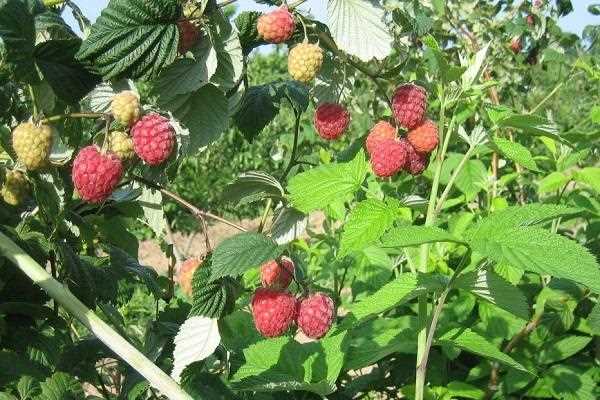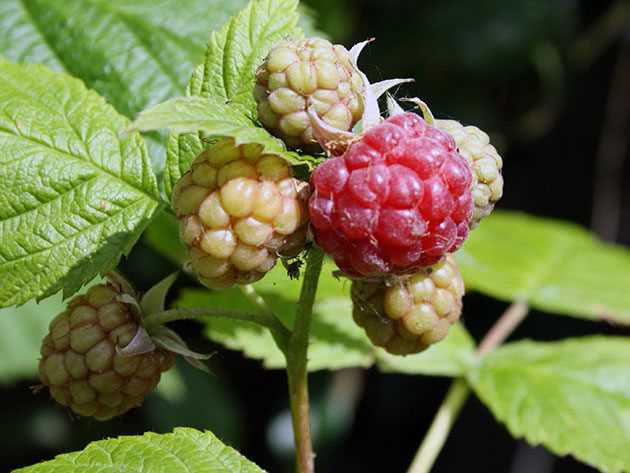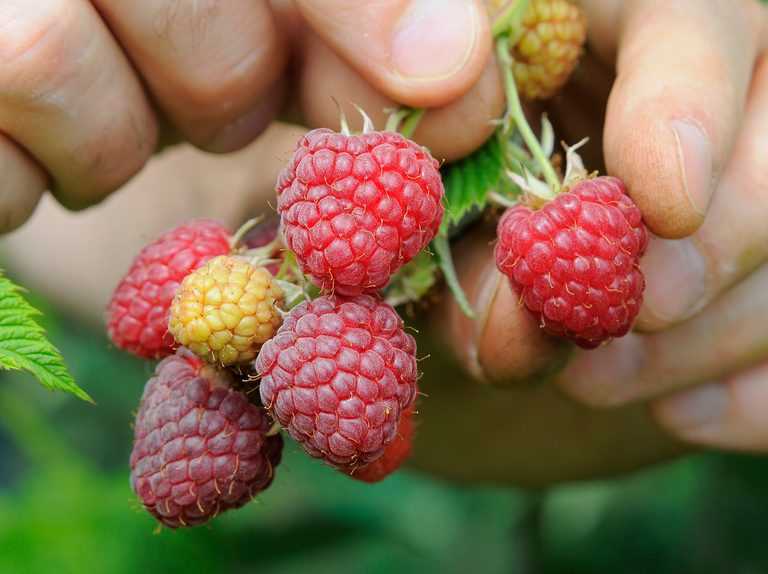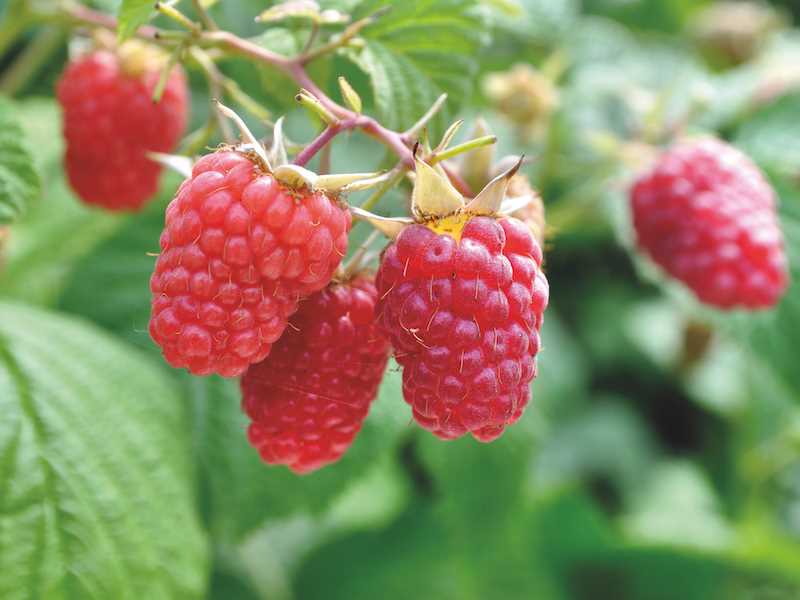- Benefits of Summer Planting Remontant Raspberries
- Choosing the Right Variety for High Yield
- 1. Climate Compatibility
- 2. Disease Resistance
- 3. Flavor and Texture
- 4. Harvest Time
- 5. Crop Size
- 6. Pollination Requirements
- 7. Growth Habit
- Selecting and Preparing the Planting Site
- 1. Sunlight:
- 2. Soil:
- 3. Clearing the Area:
- 4. Amendments:
- 5. Drainage:
- 6. Spacing:
- 7. Trellis System:
- Preparing and Planting Remontant Raspberry Canes
- Caring for Summer-Planted Remontant Raspberries
- Watering
- Fertilizing
- Pruning
- Weed Control
- Pest and Disease Management
- Harvesting
- Winter Protection
- Extended Season Techniques
- Harvesting and Pruning Remontant Raspberries
- Harvesting
- Pruning
- Troubleshooting Common Issues
- Poor Fruit Production
- Disease and Pest Infestation
- Poor Plant Health
- Question-answer:
- What are remontant raspberries?
- Are remontant raspberries difficult to grow?
- When is the best time to plant remontant raspberries?
- Do remontant raspberries need a lot of water?
- How long does it take for remontant raspberries to produce fruit?
- How do I prune remontant raspberries?
- Video: Pruning Raspberries – Why? How? When? (2020)
Are you looking for a delicious addition to your summer garden? Look no further than remontant raspberries! These berries are the perfect addition to any backyard, providing a sweet and tangy treat that can be enjoyed all summer long. If you’re ready to get started with summer planting, this step-by-step guide will help you maximize your yield and ensure a successful harvest.
Choose a Location: The first step in summer planting remontant raspberries is selecting the perfect spot in your garden. These berries thrive in full sun, so choose a location that receives at least six hours of direct sunlight each day. Additionally, make sure the soil is well-draining to prevent waterlogged roots.
Prepare the Soil: Before planting your remontant raspberries, it’s essential to prepare the soil to give your plants the best chance for success. Start by removing any weeds or grass from the planting area, as they can compete with your berries for nutrients and water. Then, loosen the soil with a garden fork or tiller, breaking up any clods and removing rocks or debris.
Plant the Raspberries: Once the soil is prepared, it’s time to plant your remontant raspberries. Dig a hole that is wide and deep enough to accommodate the plant’s root ball, typically about 12 inches in diameter and 6 inches deep. Place the plant in the hole, making sure the crown of the plant is level with the soil surface. Backfill the hole with soil, gently firming it around the roots to eliminate air pockets.
Benefits of Summer Planting Remontant Raspberries
Summer planting remontant raspberries offers several advantages that can lead to a high yield of delicious berries. Here are some benefits of choosing to plant remontant raspberries during the summer:
- Extended Harvest: One of the biggest advantages of summer planting remontant raspberries is the extended harvest period. Remontant varieties produce two crops each year – a small crop in early summer and a larger crop in late summer or fall. By planting in the summer, you can enjoy fresh raspberries for a longer period of time.
- Increased Productivity: Summer planting allows remontant raspberry plants to establish their root systems before winter, which leads to increased productivity in the following year. The plants have ample time to develop strong roots, which in turn support the growth of more canes and berries.
- Opportunity for Earlier Harvest: When you plant remontant raspberries in the summer, you give them a head start for the following year’s harvest. These plants have the potential to produce an early crop the following summer, allowing you to enjoy homegrown raspberries even before most other varieties start to bear fruit.
- Fewer Pest and Disease Problems: Summer planting can help minimize pest and disease problems. By avoiding planting in the spring, you reduce the risk of fungal diseases and pests, which are more prevalent during the wetter spring months. This gives your remontant raspberries a better chance of staying healthy and productive.
- Ability to Establish Strong Planting Bed: Planting raspberries in the summer allows you to prepare a well-drained planting bed beforehand. You can amend the soil, remove weeds, and improve drainage to create optimal growing conditions for your remontant raspberry plants.
- Convenient Timing: Summer is often a more convenient time for many gardeners to start planting. The weather is warmer, which makes gardening tasks more enjoyable, and many people have more free time during the summer months. This makes it easier to complete the necessary planting and maintenance tasks for remontant raspberries.
Overall, summer planting remontant raspberries offers several benefits that can result in a higher yield of flavorful berries. By taking advantage of the extended harvest, increased productivity, and minimized pest and disease problems, you can enjoy a bountiful raspberry harvest for years to come.
Choosing the Right Variety for High Yield
Choosing the right variety of remontant raspberries is crucial for achieving a high yield. Consider the following factors when selecting a variety:
1. Climate Compatibility
Choose a variety that is well-suited to your local climate. Different raspberry varieties have different temperature and climate requirements. Some varieties are more cold-hardy, while others thrive in warmer climates. Make sure to choose a variety that is compatible with your region’s climate to ensure optimal growth and yield.
2. Disease Resistance
Look for raspberry varieties that have good resistance to common raspberry diseases, such as powdery mildew, root rot, and cane diseases. Disease-resistant varieties will be less susceptible to these issues, resulting in healthier plants and higher yields.
3. Flavor and Texture

Consider the flavor and texture of the berries when choosing a variety. Different raspberry varieties offer unique taste profiles and textures. Some varieties are sweeter, while others have a more tart flavor. Additionally, some varieties have firmer berries, while others are softer. Choose a variety that matches your preference and intended use for the berries.
4. Harvest Time
Pay attention to the expected harvest time of the raspberry varieties. Some varieties have an early harvest, while others have a later harvest. Consider your desired harvest time and choose varieties that align with your schedule and preferences.
5. Crop Size
Consider the average crop size produced by each raspberry variety. Some varieties produce larger yields, while others have smaller yields. If your goal is to maximize yield, choose varieties that are known for their high productivity.
6. Pollination Requirements
Some raspberry varieties are self-fertile, while others require cross-pollination with another variety. If you are planting a single variety, choose a self-fertile variety. If you are planting multiple varieties, make sure they are compatible for cross-pollination to ensure optimal fruit set and yield.
7. Growth Habit
Raspberry varieties can be classified as either erect or trailing. Erect varieties have a more upright growth habit and do not require trellising. Trailing varieties spread horizontally and benefit from trellising for better support and air circulation. Consider the space available and your preference for growth habit when selecting a raspberry variety.
By considering these factors and selecting the right variety of remontant raspberries, you can ensure a high yield and successful summer planting experience. Happy gardening!
Selecting and Preparing the Planting Site
Choosing the right location for planting remontant raspberries is crucial for ensuring a successful and high-yielding harvest. Follow these steps to select and prepare the ideal planting site:
1. Sunlight:
Remontant raspberries thrive in full sun, so choose a location that receives at least 6 to 8 hours of direct sunlight each day. Avoid areas with excessive shade, as it can inhibit fruit production and increase the risk of disease.
2. Soil:

Prepare the soil well in advance of planting to ensure optimal growing conditions for your remontant raspberries. Aim for a well-draining soil that is rich in organic matter. Test the soil pH and aim for a range of 6.0 to 6.5, which is slightly acidic. If the soil is too alkaline, consider adding sulfur or peat moss to lower the pH.
3. Clearing the Area:
Clear the planting area of any weeds, rocks, or debris. Remove any existing plants or grass, as they can compete with the raspberries for nutrients and water. Use a garden fork or tiller to loosen the soil and create a loose, crumbly texture.
4. Amendments:
If the soil lacks fertility, consider adding organic amendments such as compost or well-rotted manure. These amendments will help improve the soil structure, increase nutrient content, and enhance water retention.
5. Drainage:

Remontant raspberries prefer well-drained soil to avoid waterlogged roots, which can lead to root rot and other diseases. If your site has poor drainage, consider planting the raspberries in raised beds or mounds to improve drainage.
6. Spacing:
Ensure that you have enough space for the remontant raspberry plants. Maintain a distance of about 2 to 3 feet between each plant and leave at least 6 feet between rows. This spacing will allow for proper air circulation and prevent overcrowding.
7. Trellis System:

Consider installing a trellis system before planting remontant raspberries. This will provide support for the plants as they grow, improve air circulation, and make it easier to harvest the fruit. Install sturdy posts and stretch trellis wires between them, creating a support structure for the canes.
By carefully selecting and preparing the planting site, you can create optimal growing conditions for your remontant raspberries and enjoy a bountiful harvest. Take the time to prepare the soil, ensure adequate sunlight, and provide proper support for the plants, and you’ll be rewarded with delicious, homegrown raspberries throughout the season.
Preparing and Planting Remontant Raspberry Canes
Before planting remontant raspberry canes, it’s important to prepare the soil and choose the right location for your raspberry patch. Follow these steps for successful planting:
- Choose a sunny location: Remontant raspberries thrive in full sun, so select a spot in your garden that receives at least 6-8 hours of direct sunlight each day.
- Prepare the soil: Start by removing any weeds or grass from the planting area. Loosen the soil and remove any large rocks or debris. Raspberries prefer well-draining soil, so consider amending the soil with organic matter such as compost or well-rotted manure.
- Spacing: Space your raspberry canes around 2-3 feet apart to allow for good airflow and prevent the spread of disease. Dig a row or trench that is about 8-12 inches wide and deep enough to accommodate the roots of your raspberry canes.
- Planting: Gently place each raspberry cane into the prepared hole, ensuring that the bud union (the swollen area where the cane was attached to the rootstock) is level with or slightly above the soil surface. Backfill the hole with soil, firming it gently around the base of the cane.
- Watering: After planting, water the raspberry canes thoroughly to settle the soil around the roots. Keep the soil consistently moist but not waterlogged throughout the growing season.
- Mulching: Apply a layer of organic mulch, such as straw or wood chips, around the base of the raspberry canes to help retain moisture, suppress weeds, and regulate soil temperature.
- Support: Remontant raspberry canes can grow quite tall and become top-heavy when laden with fruit, so it’s important to provide them with support. Install a trellis system, using stakes and wires, or use a raspberry-specific trellis to keep the canes upright and prevent them from bending or breaking.
By following these steps, you’ll ensure that your remontant raspberry canes are properly planted and well-positioned for high yield and healthy growth throughout the summer season.
Caring for Summer-Planted Remontant Raspberries
Watering

Proper watering is essential for the health and productivity of summer-planted remontant raspberries. Water the plants regularly, making sure the soil remains moist but not waterlogged. During hot summer months, you may need to water the plants more frequently to prevent them from drying out. Consider using a soaker hose or drip irrigation system to ensure the water is being delivered directly to the root zone.
Fertilizing
To promote healthy growth and high yield, it is important to provide regular fertilization to your summer-planted remontant raspberries. Apply a balanced fertilizer, such as a 10-10-10 formula, in early spring and again in late summer. Alternatively, you can use organic fertilizers, such as compost or well-rotted manure. Follow the manufacturer’s instructions or consult a local gardening expert for specific dosage recommendations.
Pruning
Pruning is an important part of caring for summer-planted remontant raspberries. After planting, prune the canes to approximately 6 inches above the ground to promote strong growth and encourage the development of lateral branches. In subsequent years, prune the canes that have produced fruit down to the ground in late winter or early spring. This will stimulate the growth of new canes and maintain the plant’s productivity.
Weed Control
Keep the area around your summer-planted remontant raspberries free from weeds to reduce competition for nutrients and water. Regularly remove any weeds that appear around the plants, taking care to avoid damaging the shallow roots. Consider applying a layer of organic mulch, such as straw or wood chips, to further suppress weed growth and conserve moisture.
Pest and Disease Management
Monitor your summer-planted remontant raspberries regularly for signs of pests or diseases. Common pests that affect raspberries include aphids, raspberry beetles, and spider mites. If you notice any infestations, consider using organic pest control methods or consult a local gardening expert for appropriate treatment options. In terms of diseases, keep an eye out for powdery mildew, gray mold, and root rot. If any symptoms are observed, promptly take action by removing infected plant material and applying appropriate fungicides or treatments.
Harvesting
Remontant raspberries have the ability to produce two crops in a single year. The first crop will be produced on the new canes that grow in the current year, while the second crop will grow on the same canes later in the season. Harvest the ripe raspberries by gently picking them from the plant, taking care not to damage the delicate fruit. Raspberries are best when they are fully ripe, so wait until they turn deep red before harvesting. Regularly check the plants for new fruit and harvest as they ripen to ensure a continuous supply throughout the summer and early fall.
Winter Protection
Provide winter protection for your summer-planted remontant raspberries to ensure their survival and productivity for the following year. In late fall, after the plants have gone dormant, apply a thick layer of mulch around the base of the canes to insulate the roots and protect them from freezing temperatures. You can use straw, leaves, or wood chips for this purpose. Be sure to remove the mulch in the spring before new growth begins to prevent the canes from being smothered.
Extended Season Techniques

If you want to extend the raspberry season even further, consider using techniques such as row covers or high tunnels. These structures can help protect the plants from early frosts and provide a longer growing season, allowing you to enjoy fresh raspberries well into the fall. Consult a local gardening expert or agricultural extension service for more information on these techniques and their suitability for your specific region.
Harvesting and Pruning Remontant Raspberries
Harvesting and pruning remontant raspberries are important steps to ensure a high yield and healthy plants. Here is a step-by-step guide on how to properly harvest and prune your remontant raspberries:
Harvesting
- Remontant raspberries produce two crops in a year – one in early summer and another in late summer or early fall. The first crop is usually smaller while the second crop is usually the main harvest.
- Harvest the raspberries when they are fully ripe. Ripe raspberries are firm, plump, and easily detach from the plant when gently pulled.
- Gently pick the raspberries by holding the fruit between your thumb and forefinger and giving it a gentle twist to detach it from the plant. Avoid pulling too hard, as it can damage the plant.
- Harvest the raspberries regularly to prevent overripening and to encourage the plant to produce more fruit. Check the plants every 2-3 days during the harvest season.
- Place the harvested raspberries in a shallow container or basket to avoid crushing them. Handle the fruit carefully to avoid bruising or damaging the delicate berries.
Pruning
Pruning remontant raspberries helps maintain the health and productivity of the plants. Here are some pruning tips:
- Prune remontant raspberries in early spring or late winter before new growth appears.
- Remove any dead, damaged, or diseased canes. Cut them down to the ground level with sharp pruning shears.
- Thin out the canes by removing the weaker ones. Leave about 4-6 strong canes per plant for optimal growth and fruit production.
- Trim the remaining canes to a height of about 4-6 feet to promote airflow and sunlight penetration, which reduces the risk of diseases.
- After pruning, remove all the pruned canes and dispose of them away from the raspberry plants to prevent the spread of diseases or pests.
By following these harvesting and pruning guidelines, you can enjoy a bountiful harvest of remontant raspberries and keep your plants healthy and productive year after year.
Troubleshooting Common Issues
While planting and growing remontant raspberries can be a rewarding experience, there are some common issues that may arise. Here are some troubleshooting tips to help you overcome these problems:
Poor Fruit Production
- Improper Pruning: Make sure you are pruning your remontant raspberries correctly. Pruning helps stimulate new growth and promotes fruit production. If you prune too little or too much, it can negatively affect your yield.
- Lack of Pollination: If you notice low fruit production, it could be due to a lack of pollinators in your garden. Consider attracting bees and other pollinators by planting flowers or setting up bee-friendly habitats nearby.
- Poor Fertilization: Remontant raspberries require regular fertilization to thrive. If you are not providing enough nutrients to the plants, it can result in poor fruit production. Test your soil to determine its nutrient content and adjust your fertilization schedule accordingly.
Disease and Pest Infestation
- Common Diseases: Remontant raspberries can be susceptible to diseases such as raspberry leaf spot, powdery mildew, and cane blight. Monitor your plants regularly for signs of disease, and treat them promptly with appropriate fungicides or insecticides.
- Pest Infestation: Look out for common pests like aphids, spider mites, and raspberry beetles. These pests can damage the plant and hinder fruit production. Use organic pest control methods or consult with a local gardening expert for advice on controlling these pests.
Poor Plant Health
- Improper Watering: Remontant raspberries need consistent moisture to thrive. Avoid overwatering or underwatering the plants. Provide a deep soak when watering and maintain a well-draining soil to prevent waterlogged roots.
- Insufficient Sunlight: Remontant raspberries require at least six hours of direct sunlight daily for optimal growth. If your plants are not receiving enough sunlight, consider trimming nearby trees or relocating them to a sunnier spot in your garden.
- Soil Issues: Ensure that your soil has good drainage and is rich in organic matter. Poor soil quality can lead to stunted growth and nutrient deficiencies. Amend your soil with compost or other organic matter to improve its texture and fertility.
By addressing these common issues promptly and providing proper care and attention to your remontant raspberries, you can ensure a bountiful harvest of delicious fruits for years to come!
Question-answer:
What are remontant raspberries?
Remontant raspberries are a type of raspberry plant that produces fruit more than once per year. Unlike traditional raspberries which only produce fruit once in the summer, remontant raspberries produce fruit in both the summer and the fall.
Are remontant raspberries difficult to grow?
Remontant raspberries are generally easy to grow and maintain. They require similar growing conditions as traditional raspberries, including full sun and well-drained soil. However, they do require regular pruning to remove old canes and encourage new growth.
When is the best time to plant remontant raspberries?
The best time to plant remontant raspberries is in the early spring or late fall. This gives the plants time to establish roots before the summer heat or winter frost sets in. However, they can be planted at any time during the growing season as long as they are watered regularly.
Do remontant raspberries need a lot of water?
Remontant raspberries require regular watering, especially during dry spells. They prefer to be kept consistently moist, but not waterlogged, so it’s important to monitor soil moisture levels and adjust watering accordingly. Mulching around the plants can help to retain moisture in the soil.
How long does it take for remontant raspberries to produce fruit?
Remontant raspberries typically start producing fruit in their second year of growth, although some varieties may produce a small crop in the first year. It’s important to be patient and allow the plants time to establish before expecting a large harvest.
How do I prune remontant raspberries?
Pruning remontant raspberries is essential for maintaining plant health and maximizing yield. In late winter or early spring, remove all dead and damaged canes at ground level. Thin out the remaining canes, leaving about 6-8 of the strongest ones. Prune back the lateral branches to about 12-18 inches long. This will promote new growth and increase fruit production.







